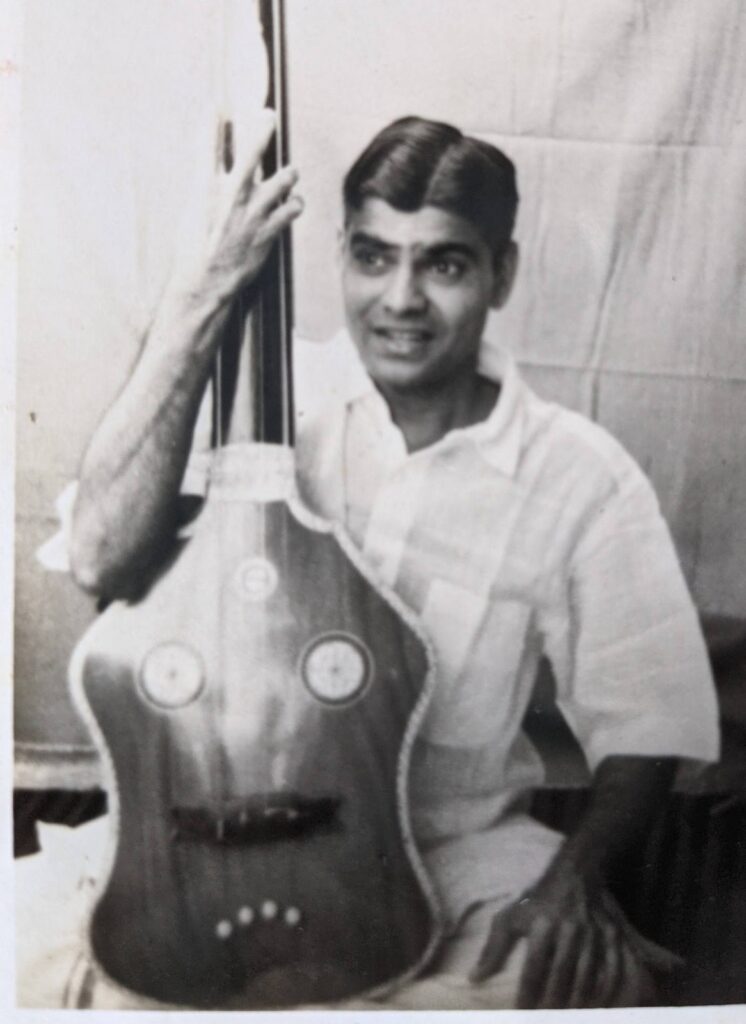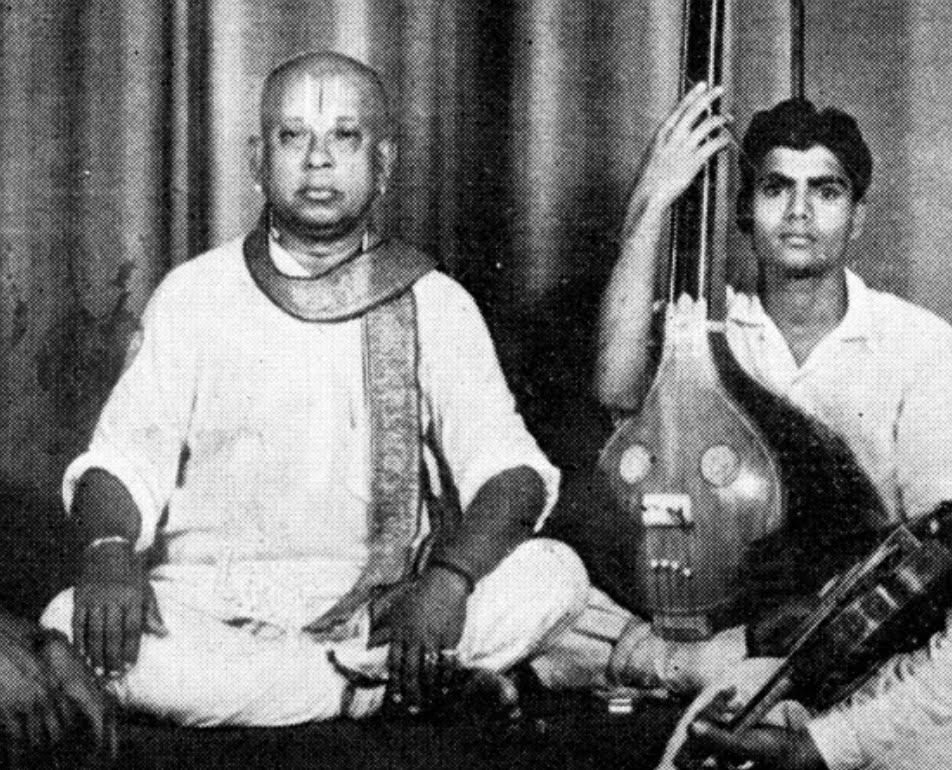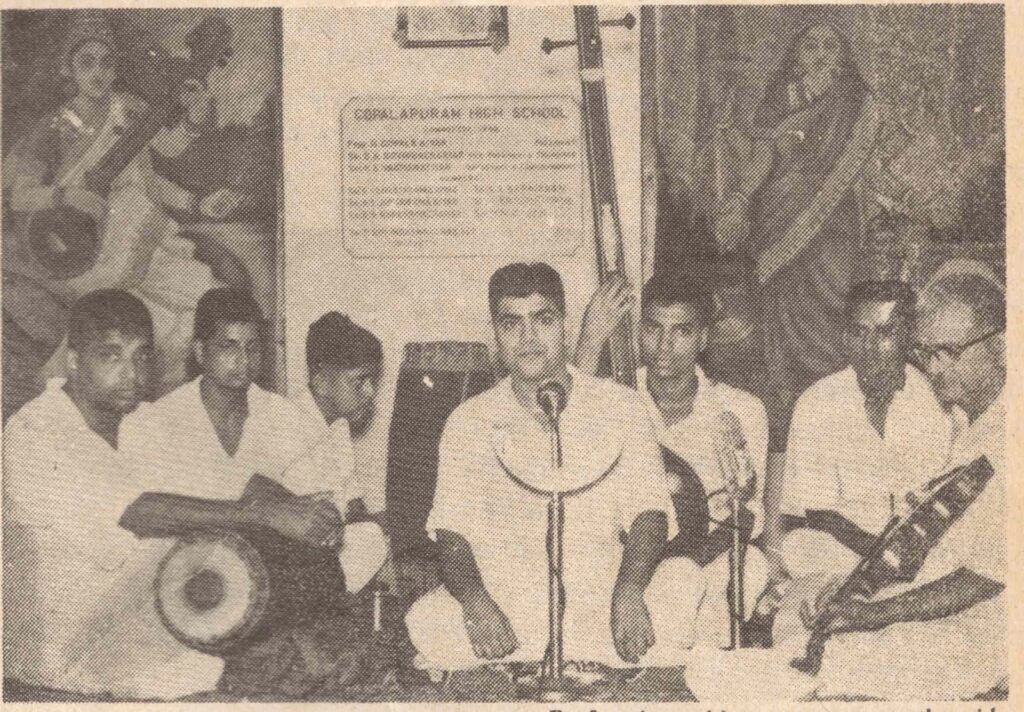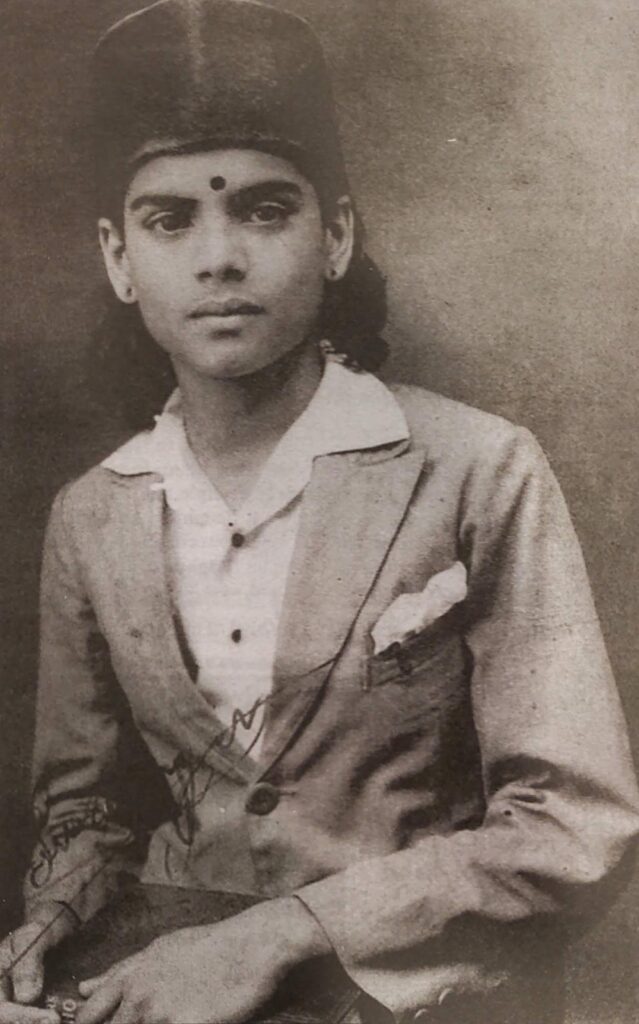KV Narayanaswamy – A Centenary Retrospective

The many awards Kollengode Viswanatha Narayanaswamy (KVN) received, including the Padma Sri, the Sangeet Natak Akademi Puraskar and the Sangita Kalanidhi, served only to publicly highlight the talents of an artiste who was already acknowledged in his own lifetime as a consummate Carnatic musician. KVN’s all-round expertise was packaged in total ease and sweetness at all registers, perfect attunement to sruti – both in stationary notes and the most intricate of gamakas, and excellent grip on laya. KVN was also a master at gauging the audience and keeping its attention with the perfect mix of pieces, presented with an impeccable sense of proportion.
This article appeared in the November 2023 issue of ON Stage, the official magazine of the NCPA (National Centre for Performing Arts). My sincere gratitude to Hemmige Sri. V Srivatsan – violinist, vocalist and student of Sri. KV Narayanaswamy. Sri. Srivatsan was the key resource for this article and supplied Alepey Sri. Venkatesan’s quotation as well. All the photographs seen on this page were also provided by Sri. Srivatsan.

Photo courtesy: Hemmige Sri. V Srivatsan.
While KVN’s music bore the stamp of his Guru Ariyakudi Ramanuja Iyengar, it reflected augmentations and improvements in line with KVN’s own musical sense and sensibilities. This went with his belief that one ought to take the best from Gurus while staying true to one’s own musical values and making the most of one’s relative strengths. Indeed, KVN made the songs he sang his own, refining and polishing them to a unique sheen.
Prior to beginning gurukulavasa in 1941 with Ramanuja Iyengar, KVN (1923-2002) learned from Palghat Mani Iyer (a mridangist), Papa Venkatramaiah (a violinist) and CS Krishna Iyer (a vocalist). Learning early from instrumental practitioners perhaps laid the keystones for his hallmarks – uncommon sensitivity and adherence to sruti and swarastana and an inbuilt sense of rhythm that made laya aspects an ingrained cake walk.
Everyone who interacted musically with KVN recollects his adoration of the tanpura and his expertise in tuning the instrument to minute perfection. Musician RK Shriramkumar (who accompanied KVN on the violin at many concerts) said that besides tanpuras tuned by KVN being sheer pleasure to listen to, seeing him tune them was a sight to see by itself. KVN could sing in perfect tune for any sruti– not just his own – adds Shriramkumar.
In the 1960s, Maragatham Ramaswamy learned from KVN at the Central College of Karnatik Music, where she graduated as Gold Medalist. She says, “Even whilst teaching a group of students, he could instantly identify the faintest of departures from sruti and who made them. It extended to insistence on perfect swarastana suddham – even in the most intricate gamakas, every single micro note had to be exactly in place.”

Photo courtesy: Hemmige Sri. V Srivatsan.
KVN’s clean sound displayed clarity and crystal-clear enunciation. While melody reigned supreme, he took a lot of care to pronounce lyrics properly, with no vowel distortion and clear delineation of aspirated and unaspirated consonants. He sang with an open, non-nasal voice that showcased stability in notes, evenness of volume and seamless breath control. There was no quiver when sustaining a note and it was near impossible to discern where he took a breath either.
A KVN concert would generally reflect a higher weightage of Thyagaraja’s compositions. Other commonly seen features were a prati-madhyama kriti (a composition with the teevra madhyam note; in Western music terminology, it would be called an augmented fourth) early on, followed by a janya (a raga whose tonal material is derived from a parent scale) of raga Kharaharapriya. They featured contrasting tempos, moods, ragas and talas. He would move from composition to composition or part to part sans gaps. Whether short or long in duration, KVN’s concerts provided fulfilment and a sense of completeness to listeners. Another distinguishing feature was his on-the-spot adaptation on stage based on his mood and the audience’s, the strengths of his co-artistes and the condition of his voice. Hemmige Srivatsan, KVN’s student who also accompanied him on the violin on many occasions, recollects his singing an entire alapana of raga Kambhoji in the madhya sthayi (middle octave)– uncommon, since Kambhoji is most frequently heard with a focus on taara sthayi (upper octave) phrases.
KVN’s manodharma was striking in how unhesitatingly effortless and free flowing it sounded to the listeners. This belied the discipline he showcased within presentations. His raga alapanas would provide a wholesome picture of the raga, yet not exceed ten minutes, even for the main pieces. One could identify the raga right away – there was no ambiguity in his phrases. No two alapanas of the same raga sounded the same.

Neraval, improvising on a line of the lyric, maintaining its syllable placement and conveying the essence of the raga, is considered the hardest aspect of Carnatic manodharma. This was undoubtedly KVN’s supreme forte. He would render it extensively, methodically and systematically in three speeds, sometimes even four. It occupied pride of place in his concerts, where it often featured in 4-5 pieces. The encomium ‘Neraval Narayanaswamy’ was a justly earned one indeed.
The judiciousness he exercised in kalpanaswaras was admirable. His sequences were crisp, brief and sweet. He avoided long, rehearsed mathematical endings, choosing to go for shorter, spontaneous ones with impromptu closings. He knew the residual count from any beat and point in the tala allowing him to come up with numerous such variations on the fly. By accenting and stressing the appropriate swaras, he portrayed the precise flavour and uniqueness of each raga as well.
The Ragam Tanam Pallavi is a capstone piece that features all aspects of Carnatic manodharma intertwined with laya. KVN preferred the traditional gana ragas here and presented both simple and complex pallavis in them. The concluding pieces at KVN’s concerts were eagerly looked forward to – the feeling and emotion he conveyed was particularly palpable in these lilting compositions, which often reduced not just listeners, but co-artistes too, to tears. RK Shriramkumar recollects such an occasion when he was so overwhelmed with emotion that he had to lay his violin down.
That KVN was acutely cognisant of the listener’s experience can be discerned from memories shared by some of his co-artistes. Anantha Krishnan is a violinist who has shared the stage with numerous Carnatic stalwarts. In his youth, he spent much time at KVN’s home, playing the violin and practicing, besides accompanying him at concerts and recordings. He fondly recollects, “KVN mama would advise me to absorb and convey the essence of what was sung in a short and crisp manner – he believed the violinist did not have to compete with the vocalist in duration to make an impact.”
Similarly, Trichur Narendran, a veteran mridangist who accompanied KVN on many concerts, mentions KVN’s comments on calibrating percussion in accordance with the song – only some songs were made, and allowed, for vociferous drumming, with many others requiring nuanced, more caressed playing. Narendran further adds that despite being junior to KVN, he was treated just as respectfully as the seniors on the concert stage with expectations not being lowered either.
KVN showcased a variety of composers in the pieces he performed. Besides the Trinity and other popularly known and heard composers in the Carnatic form, he presented compositions of many others from Mirabhai to Kabir to Vedanayakam Pillai to Iraiamman Tampi. He also tuned many lyrics that have since been in popular circulation.
What KV Narayanaswamy’s legacy is, and why it is enduring and will continue to live on, is best summarised by the articulate words of vocalist Alepey Venkatesan, a fellow student of Ariyakudi Ramanuja Iyengar: “The first aspect that comes to mind when you mention KVN is the impeccable, immaculate, amazingly consistent sruti suddham he achieved and maintained throughout his long career. It was a stupendous achievement, almost without parallel in South India in the latter half of the 20th century. He was a peerless perfectionist who conquered and transcended all the usual limiting factors (such as speed, octave and syllable), as if to proclaim that consistent unison with sruti is not the exclusive prerogative of the Hindustani singer. For demonstrating that fact alone, every Carnatic musician is beholden to KVN.”

Many thanks to Smt. Maragatham Ramaswamy, Sri. Anantha Krishnan, Sri. Ashwath Narayanan and Sri. Arijit Mahalanabis for their assistance with this article.
Related Links:
Wonderful tribute to a colossus ! Had the privilege of listening to KVN numerous times…always wanting more!
Thank you for reading and for sharing your thoughts, Naresh-ji. Much appreciated.
It was a pleasure reading the piece which aptly brought out the technical nuances of Sri KVN’s music. Yes, he was undoubtedly a connoisseur’s delight.
Thank you for reading and commenting.
Every bit of what you say about KVN Mama’s music, I can relate to. He sang at Cheenu’s wedding and we were so honored. After your piece, no more need be said. You have described his music in a way that I hear his pieces. Thank you for this beautiful piece of writing g.
You really are too kind. I was there at Cheenu’s wedding and saw and heard that concert live. So glad to have had that opportunity.
I am an ordinary and basic listener of karnatic music.
Extremely happy and joyful to know more about the great personalities.
Our country and the present generation really gifted to have them in our midst. Hundreds of thanks for the write-up on these giants.
Thank you very much, Sir. Happy that this was informative for you. No listener is ordinary, Sir – everyone is important. The music would not exist without the rasikas.
A wonderful tribute to a great musician. Thank you for the wonderful photos too
Thank you for reading and for commenting, Sir.
Excellent article on the peerless Vidwan Shri KVN Sir! KVN’s music is divine and sublime and thanks to technology, we and future generations can still listen to recordings of his concerts! KVN’s tonal quality is unmatched! Lakshmiji, you have researched KVN’s music in great detail and painted a wonderful canvas of KVN’s music! Vidwan Shri KVN Sir is truly immortal! Surely His Disciples like Aswath Narayanan and Pattabhirama Panditji will take KVN’s musical legacy forward in the future! Long Live KVN Sir’s Magnificient Music!
Thank you for reading and for your kind comments.Much appreciated.